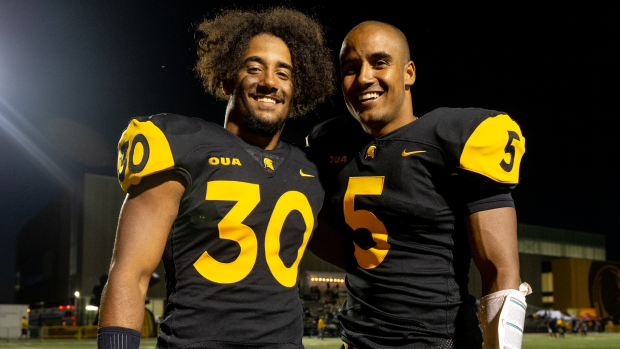Mar 25, 2022
Ford twins illustrate the conundrum of modern CFL scouting
A generation ago, CFL teams could select a defensive back or quarterback from the Canadian university ranks without a worry in the world about the NFL. But times are changing, Dave Naylor writes.
By Dave Naylor

University of Waterloo Warriors' Tre and Tyrell Ford illustrate the conundrum of modern Canadian Football League scouting and team building.
The twin brothers, Tre, a quarterback, and Tyrell, a defensive back, are tremendous athletes whose physical measurements match up with some of the very best prospects anywhere coming out of college football this spring.
A little more than a week after impressing NFL and CFL scouts as special guests at the University of Buffalo’s pro day, the pair are expected to put their assets on display alongside dozens of other top prospects for this year’s draft at this weekend’s CFL Combine, which runs Friday through Sunday in Toronto.
The fact that they come from a school not known for producing pro talent, and that they play positions not typically played by Canadians at the professional level, hasn’t diminished interest on either side of the border.
The dilemma for CFL teams is trying to decide when a player with NFL interest is worth the risk. That debate has always been part of the process, and there are many examples of teams drafting a player who winds up making it in the NFL, leaving them with nothing.
Those bets have largely been restricted to Canadians who played NCAA football, and usually along one of the lines of scrimmage.
But that line has been blurring of late, with more and more Canadian players from what are considered the speed and skill positions – receiver, running back, quarterback and defensive back – starting to get traction from NFL scouts and teams.
That brings us to the Ford twins.
A generation ago, CFL teams could select a defensive back or quarterback from the Canadian university ranks without a worry in the world about the NFL, as those positions were tough to crack for Canadians in the CFL, never mind in the NFL.
The fact that young Canadians are now excelling at those positions while holding onto their NFL dreams is quite the evolution.
The Ford twins’ athleticism helps open the door, as demonstrated in Buffalo where Tre ran a 4.45 40-yard dash, had a 36-inch vertical jump and broad jumped 10 feet, 5 inches, marks that were each slightly bested by his brother. Both run track at Waterloo as well as playing football.
Tre’s athleticism could result in teams wanting to move him to another position, but he’s drawn raves for the way he can throw the football and move with the ball in his hand.
He won the Hec Crighton Trophy last season as the outstanding player in Canadian university ball, finishing his career at Waterloo with 64 touchdowns and 24 interceptions over four seasons, while also rushing for more than 2,800 yards.
Tyrell is a two-time all-Canadian at defensive back and accomplished returner as well.
Both have firmly set their sights on the NFL, even though the path for either of them is not well-worn.
When it comes to Canadian university quarterbacks transitioning to the NFL, there’s a very limited body of work.
Three years ago, UBC’s Michael O’Connor was invited to Seattle’s minicamp but never made it further before signing a contract with the Toronto Argonauts. (O’Connor is now a member of the BC Lions, his third team in three seasons.)
In 1980, Western quarterback Jamie Bone signed with the Dallas Cowboys, but was cut early in training camp.
The University of Toronto’s Dan Feraday was selected by Cincinnati in the 12th round of the 1982 NFL draft and only saw limited preseason action before being released (the draft was shortened to seven rounds in during the 1990s).
Another Western quarterback, Steve Samways, drew some NFL interest in the mid-80s. A decade later, Acadia’s Larry Jusdanis became the first and only Canadian university quarterback invited to the NFL Combine.
And that’s about it.
In terms of defensive backs going from Canadian university ball to the NFL, it’s also a short list. There was Concordia’s Mark Montreuil, a seventh-round pick of the San Diego Chargers who played three NFL seasons from 1995-97. And former Regina Ram Tevaughn Campbell, who spent four seasons in the CFL before landing an NFL job with the Chargers in 2019.
Both Fords face mountains to climb before reaching their NFL goals and will have to overcome the doubts teams may have about the ability of players to transition from the speed of the Canadian university game.
That’s why, regardless of NFL interest, both are expected to be high selections when the CFL Draft takes place on May 3.
Whether they ultimately make it or not in the NFL or not, the Fords will have moved the line for who can be considered an NFL prospect and perhaps open doors for those who come after them.
In the meantime, they’ve given every CFL team something to chew on leading up to draft day.

